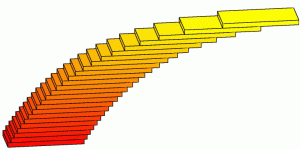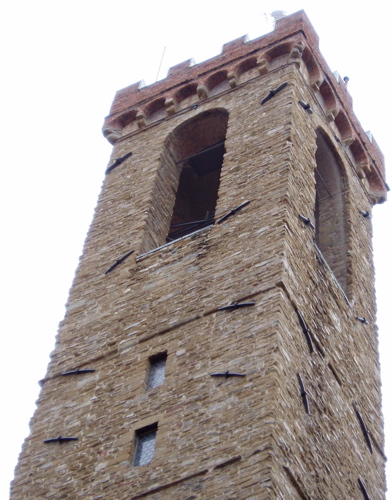Stability and engineering of masonry structures
|
"...the nature of the design problem in large masonry buildings is peculiarly adapted to the limitations of the pre-scientific mind." [J.E. Gordon p. 171] |
 A critical stack of dominoes from "All a Matter of Balance" [Sangwin 04] |
Agenda
- A couple of notes about wikis and mailing list.
- Changes, Search, WebStatistics, HTML (WikiTips? )
- PersonalNotebookPagesME21N
- get some people to help take wiki notes in class
- Briefly review LeaningTowerAssignmentME21N efforts from Freshman seminar.
- Discuss stability versus strength and how each is important for masonry, statues, etc.
- How does stone fail? StoneStrengthAndFailureModes
- hands-on demos & discussion (bring materials, tools)
- examples (Michelangelo's David, Leaning Tower, other?)
- what are some of the engineering issues associated with monumental sculptures? with buildings?
- challenges of marble transport, ErectingInPlace (preview of machine design issues) examples from Museo SS in Florence
- See colum-raising machine from modelli section of the museum.
- Discussion of Gordon reading on masonry & related issues
- Ring software demo (bring PC laptop or else install on PC in classroom...) -- linked on ArchDomeConstruction page
Notes
When designing structures, the two main possibilities for catastrophic failure are inadequate strength and inadequate stabilityStrength
Strength is about whether the material will fail (in rupture, shear, by cracking, etc.). If a rope snaps, a wooden beam cracks, or a metal rod is deformed, these are failures of strength. We will cover these later. See StoneStrengthAndFailureModes for more on strength.Stability
Stability, in contrast involves a collapse of a structure that does not occur through material failure. If a stack of blocks topples over, or an arch of stones collapses, these are failures of stability. See ArchDomeConstruction for more on stability. Corbelled Arches are one particularly simple kind of structure. The structure achieves stability due to the dead weight of each block and any blocks stacked on top of it. The corbelled structure can be divided at any height and the upper portion examined in isolation. The analysis of stability is particularly simples because there are no horizontal forces, only vertical loads (and some bending moments within overhanging blocks -- but this is a strength issue; not stability).Links and details
- ArchDomeConstruction -- issues associated with Roman arches, domes, their foundations, stresses and stability.
- StoneStrengthAndFailureModes -- decided to create a new page on this -- MarkCutkosky Jan 09-2005
Guiding Questions
In masonry structures, built up from stone blocks or bricks, with or without mortar, stability (not strength) is often the primary consideration. Why? Gordon points out that masonry structures are one of the few areas of engineering for which it works satisfactorily to scale up from small models. Why is this true? More detailed questions:- Why will a stack of dominoes actually fail sooner than the theoretical analysis in (Sangwin 04) suggests?
- What is the real functional role of mortar between stones in a masonry structure?
- What are some recent major engineering failures due to insufficient stability?
- What is "centering" and what can go wrong with it?
- What are the main failure modes of arches?
- How can pinnacles improve the stability of a vault?
- What is the line of thrust and why does it matter?
- What is the rule of the "middle third" and why is 1/3 the important ratio?
- Why are monumental works of architecture among the most long-lasting of aesthetic achievements?
- What are some of the main challenges associated with extracting, transporting and sculpting large pieces of stone?
- Is Michelangelo's David in danger of failing? What could be done about it?
- Tie rods on Bargello?:

Ideas, requests, problems regarding TWiki? Send feedback